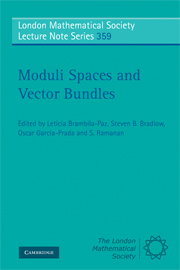Book contents
- Frontmatter
- Contents
- Preface
- Acknowledgments
- Part I Lecture Notes
- 1 Lectures on Principal Bundles
- 2 Brill-Noether Theory for Stable Vector Bundles
- 3 Introduction to Fourier-Mukai and Nahm Transforms with an Application to Coherent Systems on Elliptic Curves
- 4 Geometric Invariant Theory
- 5 Deformation Theory for Vector Bundles
- 6 The Theory of Vector Bundles on Algebraic Curves with Some Applications
- Part II Survey Articles
- Part III Research Articles
6 - The Theory of Vector Bundles on Algebraic Curves with Some Applications
Published online by Cambridge University Press: 07 September 2011
- Frontmatter
- Contents
- Preface
- Acknowledgments
- Part I Lecture Notes
- 1 Lectures on Principal Bundles
- 2 Brill-Noether Theory for Stable Vector Bundles
- 3 Introduction to Fourier-Mukai and Nahm Transforms with an Application to Coherent Systems on Elliptic Curves
- 4 Geometric Invariant Theory
- 5 Deformation Theory for Vector Bundles
- 6 The Theory of Vector Bundles on Algebraic Curves with Some Applications
- Part II Survey Articles
- Part III Research Articles
Summary
Peter Newstead and I started working on vector bundles at about the same time. We have shared many ideas for over four decades although we never actually collaborated. I am happy to contribute this summary of some of these areas of common interest to this Festschrift on the occasion of his turning sixty-five.
Introduction
The theory of vector bundles has many ramifications. One can study it from number theoretic, algebraic geometric and differential geometric points of view. It has also proved useful to mathematical physicists interested in Conformal Field theory, String theory, etc. In this account, I will mainly deal with the geometric aspects, both algebraic and differential, and will confine myself to just a few remarks on the number theoretic point of view.
The classical theory of abelian class fields seeks to understand Galois extensions of a number field in terms of the number theoretic behaviour of the corresponding integral extensions of the ring of integers in the number field. This has a geometric analogy. Consider any compact Riemann surface. Any finite covering of the surface gives a (finite) extension of the field of meromorphic functions on it. The attempt to try and understand abelian extensions of this field in terms of geometric data on the Riemann surface leads to the theory of Jacobians of Riemann surfaces.
- Type
- Chapter
- Information
- Moduli Spaces and Vector Bundles , pp. 165 - 210Publisher: Cambridge University PressPrint publication year: 2009
- 2
- Cited by



